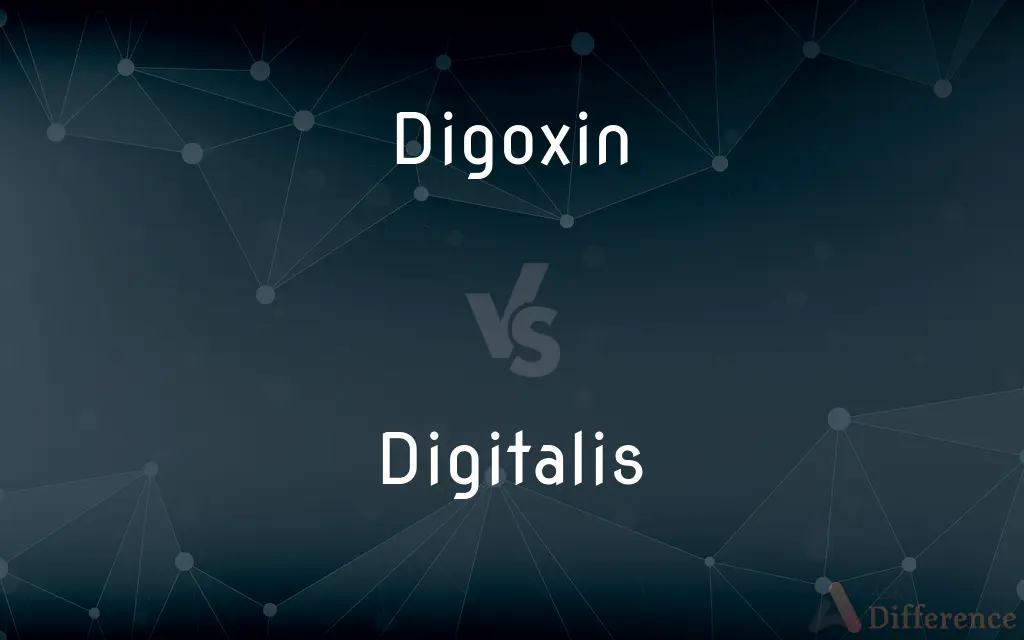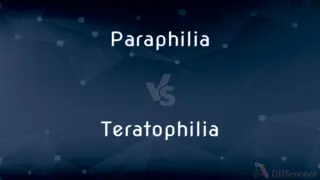Digoxin vs. Digitalis — What's the Difference?
By Urooj Arif & Maham Liaqat — Updated on March 12, 2024
Digoxin is a specific medication derived from Digitalis plants, used primarily to treat heart conditions. Digitalis refers to a genus of plants known for their cardiac glycosides.

Difference Between Digoxin and Digitalis
Table of Contents
ADVERTISEMENT
Key Differences
Digoxin is a purified cardiac glycoside extracted from the leaves of Digitalis lanata or sometimes Digitalis purpurea. It is used in the treatment of various heart conditions, including atrial fibrillation, atrial flutter, and sometimes heart failure that cannot be controlled by other medication. Digoxin works by increasing the force of heart contractions, which can be beneficial in improving heart function and controlling heart rate. On the other hand, Digitalis is a genus of plants, commonly called foxgloves, which are known for their heart-active glycosides. These plants have been used medicinally for centuries to treat heart conditions but require careful dosing due to their narrow therapeutic index.
While digoxin is a specific compound with well-defined dosages and administration methods for therapeutic use in heart disease, Digitalis plants contain a variety of cardiac glycosides, not all of which are used medically. The therapeutic compounds in Digitalis plants must be carefully extracted and purified to be used safely as medication due to their potency and potential toxicity.
The mechanism of action of digoxin involves inhibiting the sodium-potassium ATPase pump in heart cells, which leads to an increase in intracellular calcium concentrations and stronger heart muscle contractions. This effect can improve heart function and control the rate at which the heart beats. In contrast, while the Digitalis genus includes species that are sources of digoxin and other cardiac glycosides, the use of the plant itself in medicine requires precise knowledge of its glycoside content to avoid toxicity.
Digoxin's clinical use is carefully monitored to avoid side effects, which can include nausea, vomiting, dizziness, and visual disturbances, among others. Its therapeutic window is narrow, meaning the difference between effective and toxic doses is small. In comparison, Digitalis plants, if not used correctly, can cause severe toxicity, including heart arrhythmias, gastrointestinal disturbances, and even death.
Digoxin represents a specific, clinically used derivative of Digitalis plants, optimized for safety and efficacy in treating certain heart conditions. The distinction between digoxin and Digitalis is crucial in medical practice, highlighting the difference between a pharmaceutical agent and the natural source from which it is derived.
ADVERTISEMENT
Comparison Chart
Nature
Medication derived from Digitalis plants
Genus of plants containing cardiac glycosides
Use
Treats atrial fibrillation, atrial flutter, and heart failure
Source of cardiac glycosides for medical use
Mechanism of Action
Inhibits sodium-potassium ATPase pump, increases heart contraction strength
Contains glycosides that affect heart muscle and rate
Administration
Precise dosing and monitoring required
Requires extraction and purification for medicinal use
Side Effects/Risks
Nausea, dizziness, visual disturbances, narrow therapeutic index
Potentially toxic if not used correctly, can cause severe toxicity
Compare with Definitions
Digoxin
A specific heart medication.
Digoxin is prescribed to improve heart function.
Digitalis
A genus of flowering plants.
The Digitalis genus includes various species of foxgloves.
Digoxin
Derived from Digitalis lanata.
The active ingredient in digoxin comes from foxglove plants.
Digitalis
Requires careful dosing when used medicinally.
The therapeutic use of Digitalis extracts must be precisely controlled.
Digoxin
Can cause specific side effects.
Some patients may experience visual changes while on digoxin.
Digitalis
Known for cardiac glycosides.
Digitalis plants have been used historically to treat heart conditions.
Digoxin
Used for specific heart conditions.
Doctors prescribe digoxin for patients with atrial fibrillation.
Digitalis
Used in the extraction of medication.
Cardiac glycosides are extracted from Digitalis for medicinal use.
Digoxin
Has a narrow therapeutic window.
Patients on digoxin require regular blood level monitoring.
Digitalis
Can be toxic if misused.
Ingesting parts of the Digitalis plant can lead to poisoning.
Digoxin
Digoxin, sold under the brand name Lanoxin among others, is a medication used to treat various heart conditions. Most frequently it is used for atrial fibrillation, atrial flutter, and heart failure.
Digitalis
Digitalis ( or ) is a genus of about 20 species of herbaceous perennial plants, shrubs, and biennials, commonly called foxgloves. Digitalis is native to Europe, western Asia, and northwestern Africa.
Digoxin
A poisonous compound present in the foxglove and other plants. It is a steroid glycoside and is used in small doses as a cardiac stimulant.
Digitalis
See foxglove.
Digoxin
A cardiac glycoside, C41H64O14, obtained from the leaves of a foxglove, Digitalis lanata, with pharmacological effects similar to digitalis.
Digitalis
A drug prepared from the dried leaves of Digitalis purpurea, used as a cardiac stimulant.
Digoxin
A poisonous compound present in the foxglove (Digitalis lanata) and other plants. It is a steroid glycoside and is used in small doses as a cardiac stimulant.
Digitalis
Any plant of the genus Digitalis (herbaceous plants of the Plantaginaceae family, including the foxglove, Digitalis purpurea).
Digoxin
A steroid glycoside, one of the cardiotonic chemical substances which is extracted from the foxglove. It is a white, crystalline substance (C41H64O14), and is a 3-substituted triglucoside of a steroid, related structurally to digitalin and digitoxin. It is used as a cardiotonic for treatment of certain heart conditions, such as congestive heart failure. Chemically it is (3
Digitalis
(medicine) A medical extract of Digitalis purpurea prescribed for heart failure etc.
Digoxin
Digitalis preparation (trade name Lanoxin) used to treat congestive heart failure or cardiac arrhythmia; helps the heart beat more forcefully
Digitalis
A genus of plants of the family Schrophulariaceae, including the foxglove.
Digitalis
The dried leaves of the purple foxglove (Digitalis purpurea), formerly used in heart disease, disturbance of the circulation, etc. Its use has been largely replaced by that of the pure active ingredient, digitalin. See digitalin.
Digitalis
A powerful cardiac stimulant obtained from foxglove
Digitalis
Any of several plants of the genus Digitalis
Common Curiosities
Are there any serious side effects of digoxin?
Yes, due to its narrow therapeutic index, digoxin can cause side effects like nausea, dizziness, and visual disturbances if not properly monitored.
Can you directly consume Digitalis plants for heart conditions?
No, due to the risk of toxicity, Digitalis plants should not be consumed directly; cardiac glycosides must be precisely extracted and dosed.
What is the main difference between digoxin and Digitalis?
Digoxin is a specific medication derived from Digitalis plants, used for treating heart conditions, while Digitalis refers to the plant genus itself.
Is digoxin used for all types of heart failure?
No, digoxin is typically used when heart failure cannot be controlled by other medications, and for certain types of arrhythmias.
What precautions should be taken when using digoxin?
Patients should have their blood levels regularly monitored to avoid toxicity, and be aware of potential side effects.
How are Digitalis plants used in medicine?
Digitalis plants are the source of cardiac glycosides like digoxin, used in precisely controlled dosages to treat certain heart conditions.
What makes Digitalis plants toxic?
The presence of potent cardiac glycosides, which can cause severe cardiovascular disturbances if ingested in inappropriate amounts.
How does digoxin work in the body?
Digoxin increases the force of heart muscle contractions by inhibiting the sodium-potassium ATPase pump, improving heart function.
Can Digitalis plants be grown for personal medicinal use?
While they can be grown as ornamental plants, using them for personal medicinal purposes is highly discouraged due to the risk of toxicity.
How did Digitalis plants come to be used in medicine?
Their medicinal properties, particularly for treating heart conditions, have been known for centuries, with their use formalized in modern medicine through the extraction and purification of compounds like digoxin.
Share Your Discovery

Previous Comparison
Paraphilia vs. Teratophilia
Next Comparison
Rarify vs. RarefyAuthor Spotlight
Written by
Urooj ArifUrooj is a skilled content writer at Ask Difference, known for her exceptional ability to simplify complex topics into engaging and informative content. With a passion for research and a flair for clear, concise writing, she consistently delivers articles that resonate with our diverse audience.
Co-written by
Maham Liaqat













































